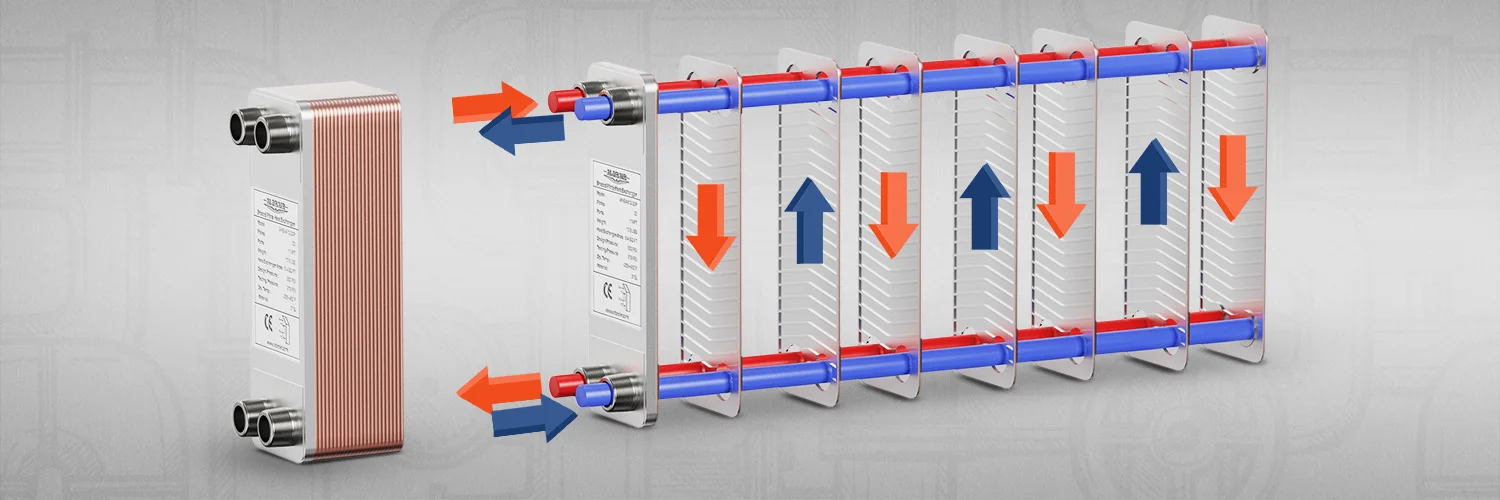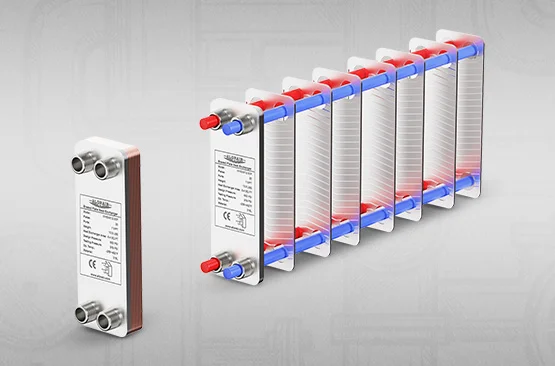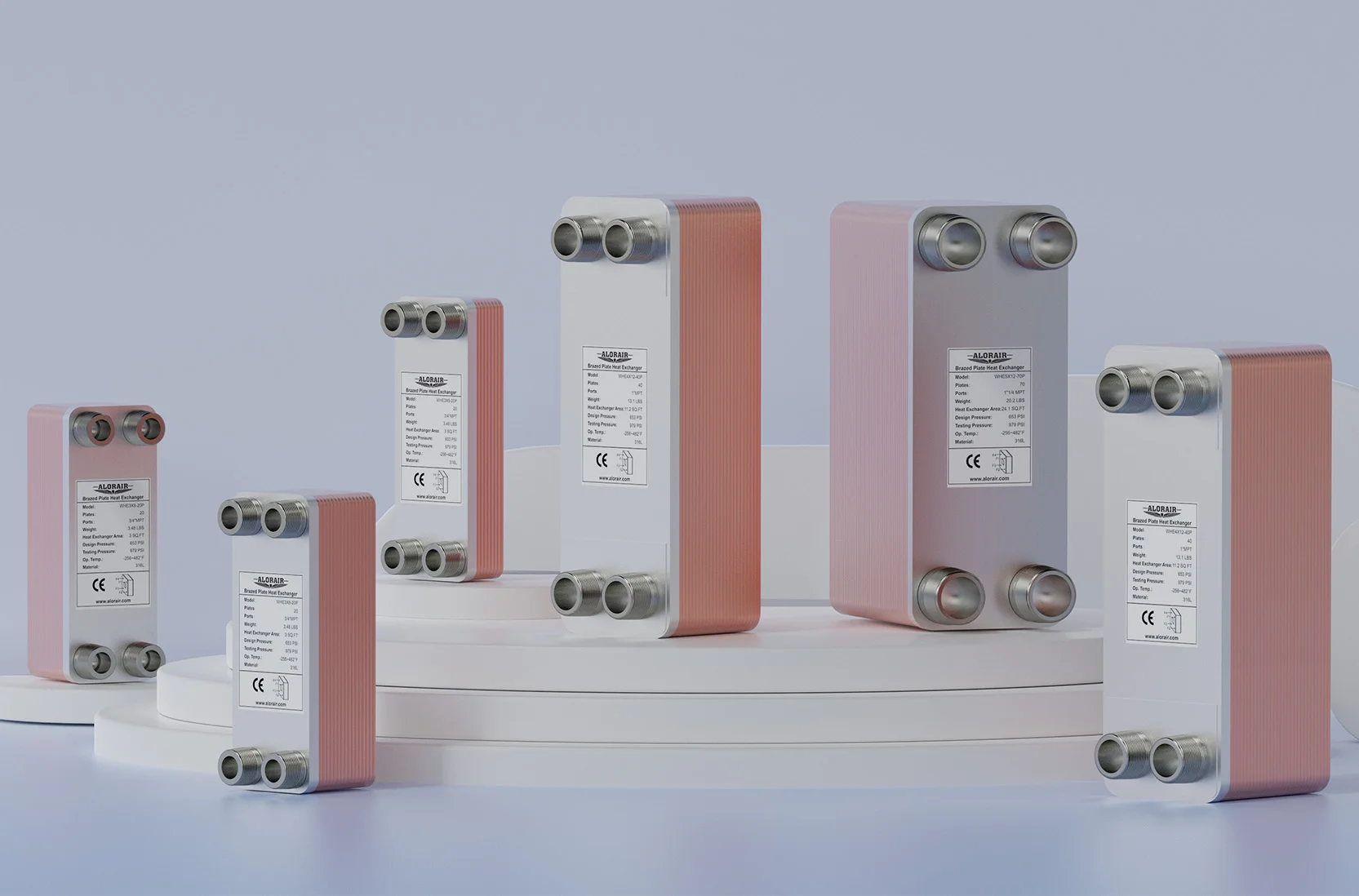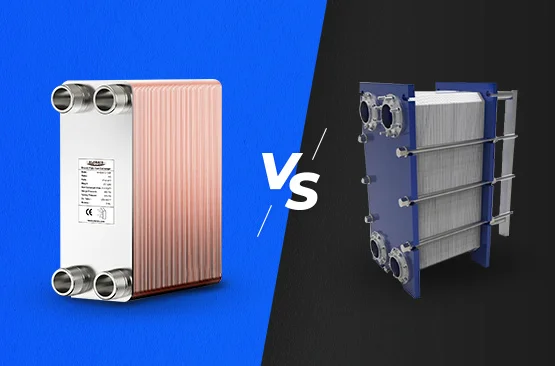The Science Behind Heat Transfer in Brazed Plate Heat Exchangers


- Author: Denrie Perez
- Date Posted:
In industrial and commercial applications, the need for high-efficiency heat exchange systems is ever-growing.
Brazed plate heat exchangers have become a preferred solution in various sectors, including HVAC, refrigeration, and chemical processing, due to their superior heat transfer performance, compact design, and low operational costs. Understanding the science behind heat transfer in BPHEs is essential for engineers and system designers to maximize their potential in real-world applications.
This post explores the key principles that govern heat transfer in BPHEs and the factors that enable them to deliver thermal efficiency.
What is a Brazed Plate Heat Exchanger
A brazed plate heat exchanger (BPHE) consists of multiple stainless steel plates that are precision-stacked and joined together using a brazing process, typically with copper as the filler material. This brazing creates a robust, leak-proof unit with multiple fluid channels designed to facilitate the exchange of heat between two separate fluids.
BPHEs are widely adopted in applications where space constraints, high performance, and energy efficiency are critical. Common uses include:
- Heat recovery systems
- District heating
- Cooling circuits in industrial processes
- Refrigeration systems
- Water-to-air heat exchangers
The compact form factor of BPHEs makes them ideal for high-density installations, while their robustness ensures long-term reliability under demanding conditions.
The Basics of Heat Transfer
Heat transfer is governed by three primary mechanisms: conduction, convection, and radiation. However, in the context of BPHEs, conduction and convection play the most significant roles in achieving high thermal efficiency.
Conduction
This refers to the transfer of heat through the solid material of the heat exchanger plates.
The efficiency of conduction depends on the thermal conductivity of the plate material, which in BPHEs is typically stainless steel. The thin nature of the plates further minimizes thermal resistance, ensuring that heat can transfer quickly across the surface.
Convection
This occurs at the interface between the fluid and the metal plates. As the fluid flows over the plates, heat is transferred from the hot fluid to the plates, and from the plates to the cooler fluid.
The efficiency of convection depends on factors such as fluid velocity, temperature difference, and the fluid’s thermal properties.
The rate of heat transfer is directly related to the temperature difference between the two fluids. The larger the temperature differential, the greater the potential for heat transfer. BPHEs are designed to maximize this temperature gradient while maintaining a stable and efficient flow of fluids through the system.
How Brazed Plate Heat Exchangers Maximize Heat Transfer Efficiency
BPHEs are designed to optimize heat transfer through several key design features and operational principles.
High Surface Area-to-Volume Ratio
BPHEs feature thin plates that provide a large surface area for heat exchange relative to the unit’s compact size. The large surface area allows for more effective heat conduction from one fluid to another, enabling efficient energy transfer.
Since the plates are stacked closely together, the overall volume of the heat exchanger remains small, making BPHEs ideal for installations where space is limited.
Turbulent Flow Induced by Plate Corrugation
The plates in a BPHE are not flat but have a corrugated design, which plays a crucial role in inducing turbulence in the fluid flow. When fluid passes over the corrugated plates, the design disrupts the laminar boundary layer, increasing turbulence.
Turbulent flow enhances heat transfer by improving mixing in the fluid, reducing the thermal resistance near the plate surfaces. AlorairCoil’s brazed plate heat exchangers are designed with a fishbone corrugated pattern, enhancing turbulence and boosting efficiency by 99%.
Counterflow Heat Transfer Configuration
One of the primary features that enhances the efficiency of BPHEs is their counterflow design. In this configuration, the two fluids flow in opposite directions, maximizing the temperature differential between the two streams.
This arrangement ensures that the heat transfer between the fluids is continuous across the entire length of the heat exchanger. It also minimizes temperature losses, resulting in higher heat transfer efficiency.
Thin Plates for Efficient Conduction
The thinness of the plates in BPHEs allows for rapid thermal conduction between the fluids. Because the material (typically stainless steel) has high temperature resistance, heat can move quickly through the plates and transfer efficiently between the fluids.
Thin plates also reduce the overall weight and size of the heat exchanger, enhancing its suitability for applications where minimizing space and weight are essential.
Multi-Fluid Flow Paths
In many BPHEs, the design incorporates multiple flow paths for the fluids, which can enhance the efficiency of heat transfer. Fluids are directed through different passes, sometimes multiple times, before exiting the heat exchanger.
This multi-pass flow arrangement increases the contact time between the fluids and the heat transfer surface, allowing for more heat to be exchanged.
Minimized Fouling and Scaling
The turbulence induced by the corrugated plates prevents the accumulation of debris and scale on the heat transfer surface. Additionally, the high velocities within the fluid flow reduce the chances of stagnant areas where deposits can build up.
While cleaning and maintenance are still necessary, the ability of BPHEs to resist fouling and scaling helps maintain high efficiency over time, reducing the need for frequent maintenance and optimizing long-term performance.
Factors that Influence Heat Transfer
Several design and operational factors influence the overall heat transfer performance of a BPHE. Among the most critical are:
Plate Geometry
The pattern and angle of the plates significantly impact the heat transfer performance. A steeper angle increases the turbulence and the associated heat transfer rate, but it also increases the pressure drop. System designers must carefully balance the heat transfer and pressure drop to optimize performance.
AlorairCoil offers 5” x 12”, 4” x 12”, and 3 x 8″ plates, plates, allowing you to select the most ideal configuration for your system’s needs.
Number of Plates
The number of plates in the stack directly correlates with the available surface area for heat transfer. While adding more plates increases surface area, it also contributes to a higher pressure drop.
As such, the optimal number of plates must be selected based on the specific heat load and flow conditions of the system. AlorairCoil offers a range of up to 80 plates, ensuring that you are able to optimize and scale your system.
Material Selection
The thermal conductivity of the plate material is a critical factor in heat transfer. Stainless steel is the most common material used due to its excellent corrosion resistance and mechanical strength. For applications involving aggressive fluids, titanium or other materials may be used to enhance corrosion resistance and maintain performance.
AlorairCoil’s brazed plate heat exchangers are constructed from 316L stainless steel and brazed with copper, delivering a durable performance under tough conditions.
Flow Configuration
BPHEs can be configured in single-pass or multi-pass arrangements. In a multi-pass system, the fluid flows through the heat exchanger multiple times, which can increase the heat transfer time but also leads to higher pressure drops.
The flow arrangement should be selected to balance heat transfer efficiency with the available pressure in the system.
Fluid Properties
The properties of the fluids being used, such as viscosity, density, and thermal conductivity also impact the heat transfer rate.
For example, higher flow rates and lower fluid viscosity generally result in higher heat transfer efficiency, while higher viscosity fluids may reduce flow speed and heat exchange.
Conclusion
Ultimately, BPHEs provide an efficient, durable, and scalable solution for a wide range of heat exchange applications, making them an indispensable tool in thermal system design.
Explore AlorairCoil’s range of brazed plate heat exchangers and upgrade your system today.
Other Posts You Might Like
10 Benefits of Brazed Plate Heat Exchangers Over Traditional Coil Systems
When it comes to efficient heat transfer, not all systems are created equal. While traditional coil heat exchangers (such as […]
The Science Behind Heat Transfer in Brazed Plate Heat Exchangers
In industrial and commercial applications, the need for high-efficiency heat exchange systems is ever-growing. Brazed plate heat exchangers have become […]
Brazed vs. Gasketed Heat Exchangers: What’s the Difference?
Efficient thermal management is key to ensuring system performance and reliability. At the heart of many thermal control systems lies […]


